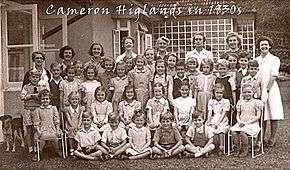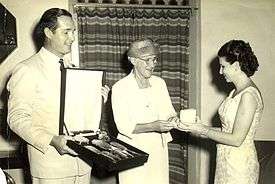Anne Griffith-Jones
| Anne L.P. Griffith-Jones | |
|---|---|
 | |
| Born |
1890 Pembrokeshire, Wales |
| Died |
1973 Ipoh General Hospital, Perak, West Malaysia |
| Resting place | Tapah, Perak, West Malaysia |
| Residence | Brinchang, Cameron Highlands, Pahang, West Malaysia |
| Nationality | Welsh |
| Occupation | Educationist (founder of Tanglin Trust School, Singapore) |
| Religion | Christianity (Anglican) |
| Awards |
MBE, OBE, Pingat Jasa Kebaktian |
Anne Laugharne Phillips Griffith-Jones OBE (born 15 April 1890) was the founder of Singapore's Tanglin Preparatory School which is now known as the Tanglin Trust School.
Born in Pembrokeshire, Wales, Griffith-Jones was the youngest of 13 children and daughter of a Welsh barrister. She, along with many women of her time, had no formal qualifications.
During World War I, she served as a welfare officer at a munitions factory in Wales, for which she was awarded an MBE.
Early years
In 1923, Griffith-Jones came to Singapore to spend a three-month holiday with her brother, Oswald Phillips ("O.P.") Griffith-Jones. After her vacation, she chose to stay in Singapore to dedicate her life to the education of expatriate children, founding the Tanglin Day School (which later became the Tanglin Preparatory School).

When the school first opened in March 1925, it functioned from two huts within the premises of the Tanglin Club. It began with five students but soon grew to 50. The school served the needs of children up to the age of eight.
At the time, many British expatriates living in Singapore had to send their children to Britain to attend boarding school at an early age. This meant being separated from their children for a lengthy period of time.
Griffith-Jones saw the need to provide a British-style education in Singapore so that parents could postpone boarding school until their children were of an older age.[1]
She (Griffith-Jones) was largely responsible for European children being able to remain with their parents in Malaya several years longer than was possible in pre-war days.
In 1934,[3] she opened a second school, the Tanglin Boarding School in the Cameron Highlands (now part of West Malaysia). The school was intended to serve as a "near-by" alternative for expatriate families living in the region who would otherwise have to send their children to boarding schools in Britain.
Many of the children who attended the school in Singapore then went on to the boarding school in the Cameron Highlands, which catered for students up to the age of 13.
At both schools, there was much emphasis on the British Empire. In preparing the boys for English Preparatory Schools, she would teach them football, taking the forward line across the playing field and showing them how to pass the ball. Similarly at cricket, she demonstrated the 'straight bat' and footwork at the crease.
Second World War

The two schools continued to grow until the outbreak of the Second World War (1942–1945). The Japanese Occupation of Malaya forced the closure of both schools.
During the war, Griffith-Jones was interned by the Japanese at Singapore's Changi Prison and Sime Road Camp. Throughout her confinement, she displayed the same qualities of organisation and leadership that were a feature of her everyday life. In the course of her imprisonment, she rose to the challenge of internment and set about establishing a school for the internees.
After the war, the two schools reopened but the school at the Cameron Highlands failed to flourish. In 1948, it had to close due to an outbreak of poliomyelitis.[4] A second closure occurred during the Malayan Emergency (1948–1960). The school had to be placed under full-time armed guard after the Malayan National Liberation Army surrounded the school. It was eventually forced to close by the Federal Government for security reasons. In 1950, the property was sold to the British War Office.[5]
Retirement

In 1958, Griffith-Jones retired to the Cameron Highlands and the British European Association, now the British Association of Singapore, took over the private company, 'Tanglin School Limited'.

While residing at the resort, Griffith-Jones became actively involved in sport and social work. For many years, she served as Secretary of the Cameron Highlands Church (which is presently known as "All Souls' Church").[6]
In mid-1958, she offered to donate a site adjoining the former Slim School grounds for the erection of a school chapel. However, after consultation with the District Officer, it was established that the State Government would not alienate any further land to the British Forces based at the retreat. Subsequently, she transferred the land to the Anglican Diocese on the understanding that a small church would be built on it.
The construction of the church commenced in 1958. The Nissen hut[7] structure was completed in September that same year. The name 'All Souls' Church' was given at the church's consecration on Thursday, 30 April 1959.[8] The Right Rev. Bishop H. W. Baines, the Bishop of Singapore and Malaya, conducted the services.
Awards
Griffith-Jones received three awards during her lifetime. Apart from an MBE she received in her twenties, she was also conferred an OBE for her services to education. In 1962, the Sultan of Pahang bestowed on her the Pingat Jasa Kebaktian award for meritorious service.
Death
Griffith-Jones died in 1973 at the Ipoh General Hospital after suffering a severe stroke. She was buried at Tapah, Perak, in the foothills of her beloved Cameron Highlands.
See also
References
- ↑ "Miss Griffith-Jones Leaving Tanglin School After 14 Years, Straits Budget, Thursday, 9 March 1939". p. 21.
- ↑ "Miss Griffith-Jones Leaving Tanglin School After 14 Years, Straits Budget, Thursday, 9 March 1939". p. 21.
- ↑ "Advertisement (Column 2), The Straits Times, 10 June 1934". p. 11. (Microfilm reel no. NL2358, National Library, Singapore).
- ↑ "School to Reopen, The Straits Times, 10 June 1948". p. 1 (Microfilm reel no. NL5228, National Library, Singapore).
- ↑ "War Office Buys School, The Straits Times, 20 November 1950". p. 8.
- ↑ "Letter to the editor: "INTER-DENOMINATIONAL CHURCH IN HIGHLANDS", The Straits Times, 20 September 1958". p. 10. (Microfilm reel no. NL3312, National Library, Singapore).
- ↑ Batumalai, Dr. S. (2007). A Bicentenary History of the Anglican Church of the Diocese of West Malaysia (1805-2005). p. 127.
- ↑ De Souza, Edward Roy (2010). SOLVED! The "Mysterious" Disappearance of Jim Thompson, the Legendary Thai Silk King (2nd ed). Word Association Publishers. p. 125. ISBN 978-1-59571-505-0. LCCN 2009944204.
External links
| Wikimedia Commons has media related to Anne Griffith-Jones. |
- Tanglin Trust School website
- T90 Cameron Highlands Expedition www.YouTube.com